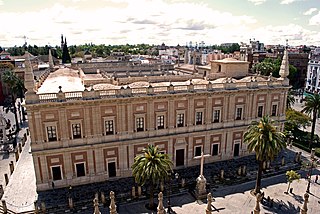Contents
This is list of archives in Ecuador.
This is list of archives in Ecuador.

Infanta Cristina of Spain is the younger daughter of the former King and Queen of Spain Juan Carlos I and Sofía. As of 2015 she is sixth in the line of succession to the Spanish throne, after her brother King Felipe VI's children, her sister Elena, and Elena's children.

The National Congress was the unicameral legislative branch of the government of Ecuador prior to November 2007.

The Archivo General de Indias, housed in the ancient merchants' exchange of Seville, Spain, the Casa Lonja de Mercaderes, is the repository of extremely valuable archival documents illustrating the history of the Spanish Empire in the Americas and Asia. The building itself, an unusually serene and Italianate example of Spanish Renaissance architecture, was designed by Juan de Herrera. This structure and its contents were registered in 1987 by UNESCO as a World Heritage Site together with the adjoining Seville Cathedral and the Alcázar of Seville.
Higinio Atilio López Riveros was a Paraguayan football striker and coach.
The National Archives of Ecuador was created on 17 January 1884, under the auspices of President José María Plácido Caamaño. The present organizational structure was created in 1938. The National Archives is located in Quito, with a branch in San Juan de Ambato.
Banking in Ecuador has a long history. At the time of the dissolution of Gran Colombia and its formation as a republic, Ecuador's economy was generally not monetized; gold and silver coins were circulated, and were brought into common use by successive currency laws. Little by little, with the growth of the nation, Ecuadorian banking also grew and was particularly centered on the city of Guayaquil. After the Liberal Revolution came a period called the Banking Plutocracy that was dominated by private banking, especially by the Commercial and Agricultural Bank of Guayaquil. This period ended with the July Revolution of 1925.

Margarita Province was one of the provinces of the Spanish Empire, then one of the provinces of Gran Colombia, and later one of the Provinces of Venezuela. In Gran Colombia it belonged to the Orinoco Department which was created in 1824. With the creation of the States of Venezuela in 1864 it became Nueva Esparta.
Julio Mario Luqui-Lagleyze is an Argentine historian. Born in Buenos Aires in 1959 received a degree in History in 1982. He specializes in Hispano-American Military and Naval History and Military Museology. He is currently studying for his PhD in History at the Universidad Católica Argentina.
The Archivo Nacional de la República de Cuba is the national archive of Cuba. Founded in 1840, it is located in Havana on Calle Compostela. Directors have included Vidal Morales Morales and Joaquín Llaverías Martínez.

Rodolfo Pérez Pimentel is an Ecuadorian lawyer, historian, and biographer. He was declared the lifetime chronicler of the city of Guayaquil, and is a member of the National Academy of Ecuadorian History. He was the 2005 recipient of the Premio Eugenio Espejo in Literature, awarded to him by President Alfredo Palacio.
Celso Gerardo Guerrero Pereira is a former association goalkeeper and current manager of Club Fulgencio Yegros of the Paraguayan Primera División C.
The Saharawi National Archive is the national archive of the Saharawi people.